An instantly fixable and self-adaptive scaffold for skull regeneration by autologous stem cell recruitment and angiogenesis
- PMID: 35523800
- PMCID: PMC9076642
- DOI: 10.1038/s41467-022-30243-5
An instantly fixable and self-adaptive scaffold for skull regeneration by autologous stem cell recruitment and angiogenesis
Abstract
Limited stem cells, poor stretchability and mismatched interface fusion have plagued the reconstruction of cranial defects by cell-free scaffolds. Here, we designed an instantly fixable and self-adaptive scaffold by dopamine-modified hyaluronic acid chelating Ca2+ of the microhydroxyapatite surface and bonding type I collagen to highly simulate the natural bony matrix. It presents a good mechanical match and interface integration by appropriate calcium chelation, and responds to external stress by flexible deformation. Meanwhile, the appropriate matrix microenvironment regulates macrophage M2 polarization and recruits endogenous stem cells. This scaffold promotes the proliferation and osteogenic differentiation of BMSCs in vitro, as well as significant ectopic mineralization and angiogenesis. Transcriptome analysis confirmed the upregulation of relevant genes and signalling pathways was associated with M2 macrophage activation, endogenous stem cell recruitment, angiogenesis and osteogenesis. Together, the scaffold realized 97 and 72% bone cover areas after 12 weeks in cranial defect models of rabbit (Φ = 9 mm) and beagle dog (Φ = 15 mm), respectively.
© 2022. The Author(s).
Conflict of interest statement
The authors declare no competing interests.
Figures

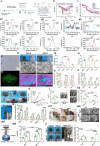
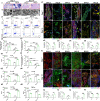

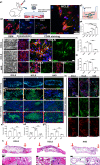


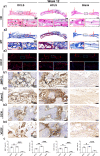
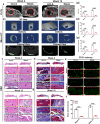
Similar articles
-
Polysaccharide-Based Composite Hydrogel with Hierarchical Microstructure for Enhanced Vascularization and Skull Regeneration.Biomacromolecules. 2023 Nov 13;24(11):4970-4988. doi: 10.1021/acs.biomac.3c00655. Epub 2023 Sep 20. Biomacromolecules. 2023. PMID: 37729544
-
Interleukin-4-loaded hydrogel scaffold regulates macrophages polarization to promote bone mesenchymal stem cells osteogenic differentiation via TGF-β1/Smad pathway for repair of bone defect.Cell Prolif. 2020 Oct;53(10):e12907. doi: 10.1111/cpr.12907. Epub 2020 Sep 19. Cell Prolif. 2020. PMID: 32951298 Free PMC article.
-
Rational design of gelatin/nanohydroxyapatite cryogel scaffolds for bone regeneration by introducing chemical and physical cues to enhance osteogenesis of bone marrow mesenchymal stem cells.Mater Sci Eng C Mater Biol Appl. 2019 Nov;104:109855. doi: 10.1016/j.msec.2019.109855. Epub 2019 Jun 5. Mater Sci Eng C Mater Biol Appl. 2019. PMID: 31500067
-
Biomimetic glycopeptide hydrogel coated PCL/nHA scaffold for enhanced cranial bone regeneration via macrophage M2 polarization-induced osteo-immunomodulation.Biomaterials. 2022 Jun;285:121538. doi: 10.1016/j.biomaterials.2022.121538. Epub 2022 Apr 25. Biomaterials. 2022. PMID: 35504180
-
Effects of nanofibers on mesenchymal stem cells: environmental factors affecting cell adhesion and osteogenic differentiation and their mechanisms.J Zhejiang Univ Sci B. 2020 Nov.;21(11):871-884. doi: 10.1631/jzus.B2000355. J Zhejiang Univ Sci B. 2020. PMID: 33150771 Free PMC article. Review.
Cited by
-
Multifunctional vitamin D-incorporated PLGA scaffold with BMP/VEGF-overexpressed tonsil-derived MSC via CRISPR/Cas9 for bone tissue regeneration.Mater Today Bio. 2024 Sep 14;28:101254. doi: 10.1016/j.mtbio.2024.101254. eCollection 2024 Oct. Mater Today Bio. 2024. PMID: 39328787 Free PMC article.
-
Hollow Hydroxyapatite Microspheres Loaded with rhCXCL13 to Recruit BMSC for Osteogenesis and Synergetic Angiogenesis to Promote Bone Regeneration in Bone Defects.Int J Nanomedicine. 2023 Jun 29;18:3509-3534. doi: 10.2147/IJN.S408905. eCollection 2023. Int J Nanomedicine. 2023. PMID: 37404852 Free PMC article.
-
Sequential simulation of regeneration-specific microenvironments using scaffolds loaded with nanoplatelet vesicles enhances bone regeneration.Bioact Mater. 2025 Apr 26;50:475-493. doi: 10.1016/j.bioactmat.2025.04.018. eCollection 2025 Aug. Bioact Mater. 2025. PMID: 40342486 Free PMC article.
-
Mussel inspired 3D elastomer enabled rapid calvarial bone regeneration through recruiting more osteoprogenitors from the dura mater.Regen Biomater. 2024 May 22;11:rbae059. doi: 10.1093/rb/rbae059. eCollection 2024. Regen Biomater. 2024. PMID: 38911700 Free PMC article.
-
Microenvironment-optimized gastrodin-functionalized scaffolds orchestrate asymmetric division of recruited stem cells in endogenous bone regeneration.J Nanobiotechnology. 2024 Nov 20;22(1):722. doi: 10.1186/s12951-024-02886-7. J Nanobiotechnology. 2024. PMID: 39563380 Free PMC article.
References
Publication types
MeSH terms
LinkOut - more resources
Full Text Sources
Miscellaneous

